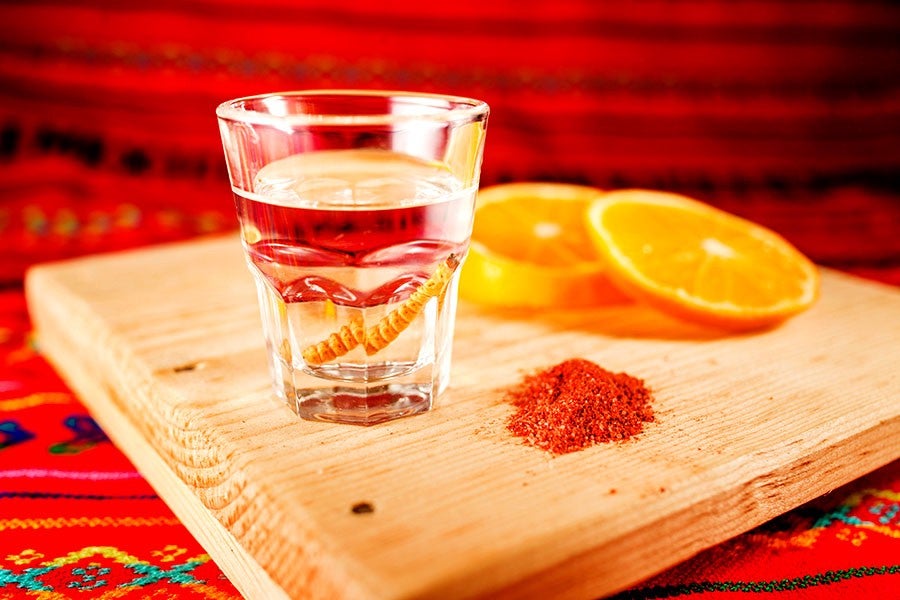Open any craft cocktail menu, and you’ll see that the hot ingredient of the day is mescal (well, okay, and egg whites). But despite the ascendency of the other agave-based spirit, for much of the last four decades, mescal has gone largely unnoticed by the average U.S. drinker. To find out more about America’s on-again, off-again relationship with the spirit, we talked to Rodrigo Rodriguez, the first man to ever import mescal to the States. Here’s what he told us about trying to convince a suspicious nation to not just drink the drink, but also eat the worm.

With mescal, it was all about the larva. That’s where the first bottle that came to the United States got its name from: Gusano Rojo — the red worm.
But before I get too far ahead of myself, a little background. Tequila is technically a mescal, but mescal isn’t a tequila — there are differences in production techniques and in the types of agave used. Tequila is only made from one type of agave plant — the agave tequilana (blue agave) — and can only be produced in the state of Jalisco and in small parts of four other states in Mexico. But since mescal can be produced from up to 28 varieties of agave (including blue agave), its flavors tend to be more aromatic and diverse.
Originally, mescal was only produced from agave plants around the city of Oaxaca, but according to government regulations, mescal also can be officially produced in some areas of the states of Guerrero, Durango, San Luis Potosi and Zacatecas.
For a long time, mescal wasn’t considered a fancy drink — it was actually the first distillate that the Spanish developed in the Americas. Originally, Native Americans like the Aztecs carved the center of the agave plant and the juices that accumulated in the the hole were then fermented in stone-fire pits. It was called pulque, and they drank it during special ceremonies. But once the Spanish arrived and they’d run out of rum, wine and brandy, they figured out they could distill the juices from the agave plant in clay and copper stills.
That’s why, for the longest time, the quality of mescal was so low: Unlike tequila, which came from a more refined distillation process in a town called Tequila, there were no regulations on mescal. Sometimes it was even mixed with other alcohols — though, for the record, the bottles of mescal that I began distributing in the U.S. were 100 percent agave.

Ever since I was in college, I was fascinated with the export business. Before I got into mescal, I was working in construction, but I was always searching for products to export out of Mexico and into the U.S. That’s when I first noticed that there was no mescal in the U.S. market. So in 1978, I met with Arturo Lozano, the son of the founder of Gusano Rojo. They were the leading producer of mescal in Mexico, and they distinguished themselves from other brands by adding a red larva to their bottles.
I decided I wanted to be the exclusive distributor of their mescal to the U.S. Later that same year, the first truckload, filled with 800 cases of mescal, arrived in California. I was in contact with a national importer — Capital Importers — based in L.A. They took the brand, and using their agents all over the U.S., began marketing the bottle to different bars and liquor stores. Each bottle cost around $16, which was the same as a bottle of Cuervo or Sauza.
The marketing pitch, of course, was based around eating the worm. (Incidentally, when the bottle is fresh, the worm is still red, but after a while, the alcohol turns the larva white.) Young Americans loved the idea of swallowing a worm! Some of them had heard rumors about this drink from their trips to Tijuana, and they believed that the worm in mescal was an aphrodisiac. It’s not, but it did make some of them crazy, although I think most of them were crazy to begin with.
I had this idea to create a club called The Worm Eaters: There was a wooden board with little brass name plates that had the date and name for each person who ate the worm. It turned out to be very successful; some bars kept mailing in brass name plates to be inscribed, even after the promotion had stopped.
We went from having one truck bringing in 800 cases every three months to a truck with 1,000 cases every month at the height of our sales. We never had any issues with bringing the mescal across the border, except for during our second shipment, when 200 cases mysteriously went missing on their way into California. To this day I have no idea what happened to those cases of mescal.
With the popularity of the drink rising, I began distributing mescal to the Saskatchewan province in Canada, and to France, Germany, Spain, England and Japan. By 1984, I had become a partner and director of Gusano Rojo.
But if there’s one thing I’ve learned about the liquor business, it’s that with each emerging generation, preferences can change. In the 1980s, mescal was rising in popularity, but by the 1990s, things began to slow down. At the same time, one of the owners of Gusano Rojo died, and the brand policies changed in such a way that it was no longer profitable for me to continue working there. That’s why I started my own vodka company using a similar marketing concept as the red worm — my brand of vodka, Skorppio, has a scorpion inside of the bottle.
Another problem with mescal was that only a few brands ever made it into the international market. It wasn’t like vodka, tequila or whiskey, where you had several brands investing in the promotion of a single type of liquor. In mescal’s case, there weren’t enough companies that were distributed internationally to justify investing in educating the public and spreading the word [as to what mescal even is]. The growth of mescal has only ever been organic. To put it in perspective, last year, Mexico exported around 3 million liters of mescal, compared to nearly 85 million liters of tequila.
Still, I think mescal has a great future. Unlike tequila, which has to be made from a single type of agave plant, mescal producers can blend multiple types of agave together, so there’s an endless number of possibilities for the flavor and aroma. And this new generation seems to appreciate it more, too — even without the worm.
So next time you’re at a bar, try a shot.
And be sure to ask for some roasted chapulines, or grasshoppers — a classic Oaxacan snack — on the side.
—As told to Andrew Fiouzi

